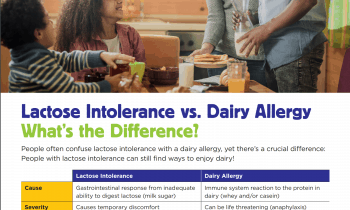This may surprise you, but lactose intolerance is a type of food sensitivity — not an allergy! It is the result of not having enough lactase, an enzyme that digests lactose, the natural carbohydrate in milk. Lactose intolerance is a very individual condition, which means people are able to tolerate different amounts of lactose.
The good news is there are lots of foods that are naturally low in lactose — like yogurt, cheese, cottage cheese, kefir and most whey protein powders. Most people can continue to enjoy the taste and health benefits of low fat and fat free dairy foods by drinking lactose-free milk, having small amounts of milk with meals or including low-lactose foods in their diet.
Diagnosing Lactose Intolerance
People who are lactose intolerant have a hard time digesting the carbohydrate (called lactose) that is naturally found in milk. Symptoms may include stomachaches, bloating or gassiness, but these symptoms can have many different causes and could also be signs of other digestive conditions.
Lactose intolerance is less common in young children. If you think you or your child is lactose intolerant, talk to your family doctor, pediatrician or dietitian before limiting dairy intake and get properly tested for lactose intolerance.
Missing Essential Nutrients
While individuals with milk allergies must avoid ALL dairy, avoidance is not necessary for those who are lactose intolerant.
Why keep delicious dairy foods in your diet? They are an important source of key nutrients, such as calcium, phosphorus and vitamin D and provide many health benefits, including sustained energy and can support a strong immune system. Health and nutrition experts agree that it’s difficult to get enough of these nutrients without dairy in your diet. And remember, plant-based beverages do not contain the same nutrient package as real milk.
Improving Digestive Health
Dairy foods are also good for your digestive health, which allows the body to properly break down food and absorb nutrients to keep you healthy. While eating a variety of foods, including enough fiber each day from whole grains, beans, fruits and vegetables can improve your gut health, it is also important to include fermented foods with live cultures like yogurt and kefir.
For those with lactose intolerance, yogurt and hard cheeses can be included in the diet because there is less lactose in hard cheeses and the live cultures in yogurt can help digest the lactose. Kefir is also a good choice for those with lactose intolerance.
Incorporating Dairy in Your Diet
If you are lactose intolerant, below are some ways you can enjoy dairy again:
- Try lactose-free milk and dairy foods. They are real milk products, just without the lactose, and provide the same nutrients as regular dairy foods.
- Enjoy easy-to-digest yogurt. The live and active cultures in yogurt help to digest lactose and Greek yogurt naturally contains less lactose – substitute it for other common ingredients in your meals.
- Choose naturally-aged cheeses. Natural cheeses such as Cheddar, Colby, Monterey jack, mozzarella and Swiss are low in lactose.
- Mix milk with other foods. Adding milk to foods like cereal, soups and sauces gives your body more time to digest lactose.
- Experiment in small amounts. Try adding small amounts of dairy foods to your diet and slowly increase the amount over several days or weeks.
Explore the lactose-free section of our recipe collection to find meals and beverages made with lactose-free dairy ingredients.





